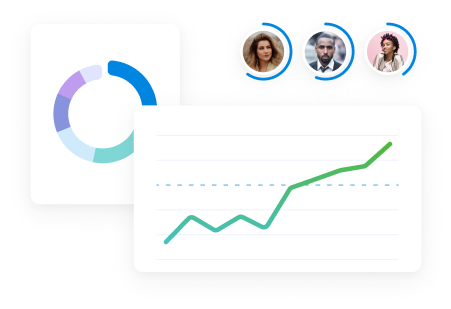What is project tracking?
Project tracking is the process of keeping an eye on how a project is progressing to make sure it’s staying on schedule, within budget, and meeting your goals.
For agencies and consultancies, this usually means checking things like how well your team is managing their tasks, how long tasks are taking, and whether the project costs are sticking to the plan.
Good project tracking helps teams stay on top of work and deliver high-quality, on-time projects that keep clients happy. It also makes it easier to keep projects profitable and use your team’s time wisely (translating to higher profit margins).
What is a project tracker?
A project tracker is any tool that helps you monitor, manage, and communicate the progress and performance of your projects.
Think of a project tracker as a GPS for your project. It shows you where you are, where you plan to go, and if you need to change directions.
Many teams try to track projects manually using spreadsheets or basic software tools.
However, this creates a lot of disorganized, disconnected information, making it harder to evaluate projects accurately and make data-driven decisions.
This lack of clarity can cause project errors, missed deadlines, and budget overruns.
Dedicated project trackers or project management software solve these issues by offering features that help in key areas, such as:
- Task management: Creating, assigning, and managing tasks for a project
- Timeline management: Offering Gantt charts, calendars, timelines, or other ways to visualize project deadlines and progress
- Resource allocation: Assigning people to specific tasks or project phases and monitoring their work capacity
- Data analysis and reporting: Seeing real-time project data and project management KPIs in one view
Some project trackers also offer features to help with budgeting, team collaboration, and resource forecasting. And may also sync with other tools in your tech stack.
For example, Scoro is a professional services automation (PSA) tool that can help your agency or consultancy track every aspect of a project in one place.
Note: We’ll dive deeper into how Scoro can help you effectively track projects below.
Why project tracking matters
If you’re not tracking projects carefully, it’s easy for things to get off course.
You might struggle with:
- Missed deadlines due to poor time management
- Budget overruns because you aren’t closely monitoring costs
- Overlooked tasks from a lack of visibility into your team’s workload
- Bottlenecks caused by assigning staff who either don’t have enough time or the right expertise for certain tasks
- Decreased client satisfaction from late deliverables or unexpected changes
Project tracking lets you see how your project is doing at all times. So, you can prioritize work more effectively, communicate clearly to clients and team members, and make staffing or timeline adjustments as needed to deliver projects on time and within budget.
Project tracking also helps you:
- Improve decision making: With a clear view of your project data, you can make informed decisions about resource planning, scope creep, and timelines
- Schedule staff effectively: By tracking how long tasks take, you can accurately plan your team’s workload, preventing bottlenecks or rushed, low-quality work
- Improve client trust: Increased project visibility and real-time updates reassure clients that their project is on track, fostering stronger relationships
- Increase project margins: Tracking your finances and resource utilization ensures you avoid overspending and overservicing, increasing project profitability
Key components of project tracking
Tracking projects is more than just reviewing a to-do list. Effective project tracking focuses on all major areas of the project, including:
- Task management: Breaking down the project into smaller parts, assigning them, setting deadlines, and tracking their progress. By defining each action that leads to a high-quality deliverable, you make sure no key steps are missed. And can deliver projects on time.
- Time tracking: Recording time spent on each project task and phase. This helps you make informed staffing and pricing decisions for projects based on how much time they’ll take and the labor costs.
- Progress monitoring: Regularly comparing your project’s pace to the initial plan to proactively identify and address issues. If you’re running behind schedule, you can quickly determine why and reallocate work, adjust timelines, or reprioritize other work as needed to catch up before things get too delayed.
- Resource allocation: Assigning team members and freelancers to tasks in a way that gives everyone enough work without burning them out. This helps you avoid overservicing, increases billable utilization, and reduces bottlenecks from overbooking.
- Collaboration: Communicating and working together with your team and clients to meet your shared goals. Having key info in one project tracker keeps things organized, making it easier to move work forward and keep everyone in the loop.
- Reporting and data analysis: Generating regular reports based on Key Performance Indicators (KPIs) to inform decision making, keep stakeholders updated, and track progress toward project goals. Continuously evaluating these metrics shows you where you went right (and wrong) across different projects, highlighting strengths as well as areas to improve on.
How to track project progress and protect your margins
Here’s how to track project progress effectively:
1. Set a clear project vision and goals
It’s difficult to figure out if a project is “successful” or not if you don’t have a clear understanding of what that success actually means.
So, start by defining what high-level success looks like, both internally (i.e., project profit targets) and with the client (i.e., project deliverables or measurable results).
Align with your client on:
- The project scope and included deliverables
- A realistic timeline for each phase of the project
- Client-facing project goals
- A project budget
With a clear vision and concrete goals in place, you know what choices you need to make from the start to help the project to succeed. For example, if a client needs a super-quick turnaround, you might assign more senior team members to ensure it gets done on time—without risking quality.
2. Establish your project KPIs
Decide which metrics you need to track to objectively measure your internal and external goals. After all, goals don’t mean much if you can’t measure progress toward them.
So, you might have a goal of ending the project with 40% profit margins.
To make sure you get there, you’d track KPIs like:
- Budgeted vs. actual costs
- Delivery costs
- Delivery (profit) margin
And let’s say you and your client want to complete the project within three months. Here, it’d make sense to pay close attention to overdue tasks, to have no more than 10% of tasks overdue at the end of each month.
By tracking these specific KPIs, you and your team have clear “North Stars” to align your work with big-picture goals.
And if you notice those metrics aren’t where you need them to be, you’ll know you need to take action to get things back on track. This prevents surprises or disappointments at the end of the project.
Further reading: 9 Project Management KPIs To Track For Profitable Projects
3. Break down projects into smaller tasks
Breaking down a large project into more manageable tasks makes it easier to estimate how much time is needed, plan the project, and track its overall progress.
For example, if you have a website redesign project and you only break it into three chunks (e.g.,. “Planning,” “Redesign,” and “Coding”), it’ll be tough to say exactly where you are in any of those phases. And if the project will be completed on time.
Instead, break down each of those phases into distinct tasks like:
- Design five webpage wireframes with the brand’s new color scheme
- Upload all webpage photos
- Get client feedback on wireframes
- Implement client feedback
Top Tip
Use a Work Breakdown Structure (WBS) to help you easily break down complex projects into smaller, manageable tasks. A WBS visually outlines the project’s phases, tasks, and subtasks, making it easier to plan and ensure nothing is overlooked.
Use Scoro’s Gantt chart to set up and track individual tasks without losing sight of the bigger project picture.
If you’ve made your initial project quote in Scoro, your high-level project phases will automatically import to the chart. If not, add them by clicking “+Name” → “Add phase.”
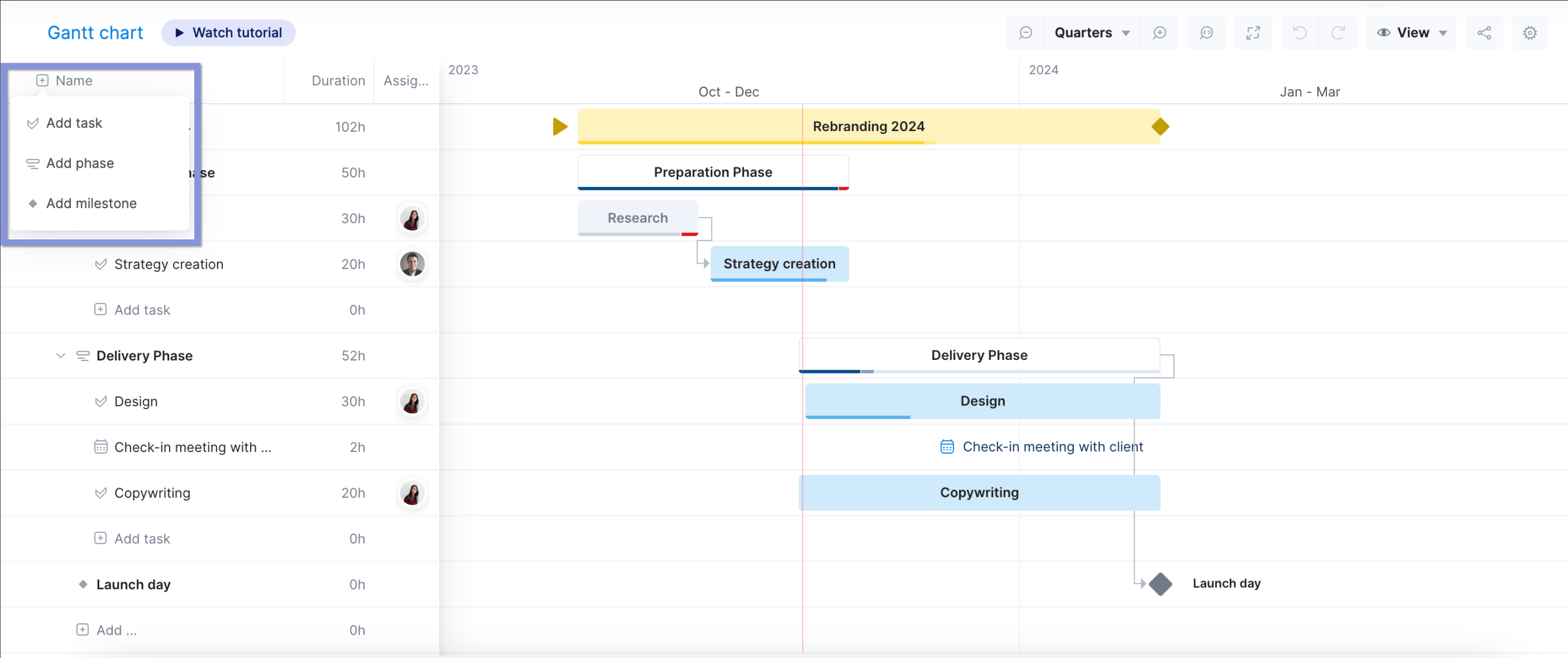
Then, click “Add task” from the drop-down or under any phase to add tasks where you need them.
You can also show how long the task should take by adding time to the task in the sidebar. Adjust timeframes by dragging and dropping the edges of the task on the Gantt chart.
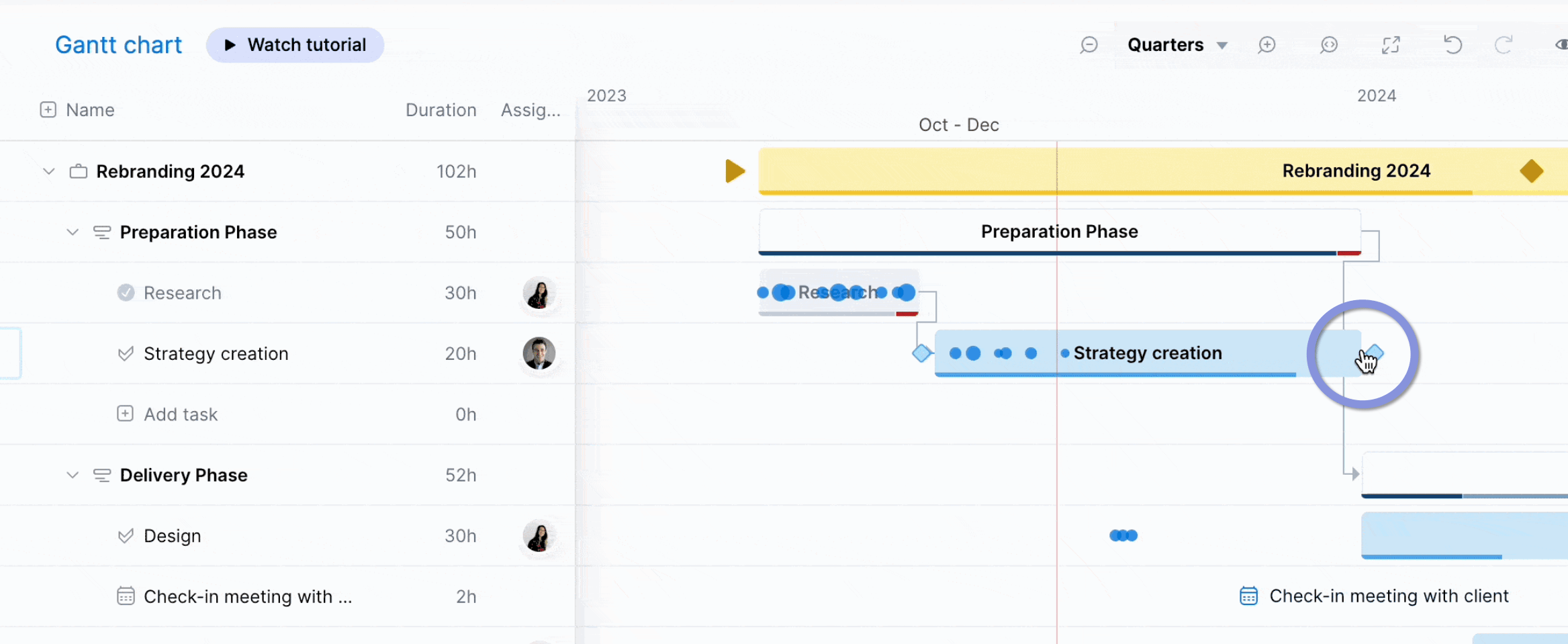
Then, identify dependencies (tasks that need another task to start or finish before it can start or finish) to create a logical order of assignments and deadlines and prevent bottlenecks.
Click the handle at the end of a taskbar and drag it to the start of the dependent task. This will link to the two tasks.
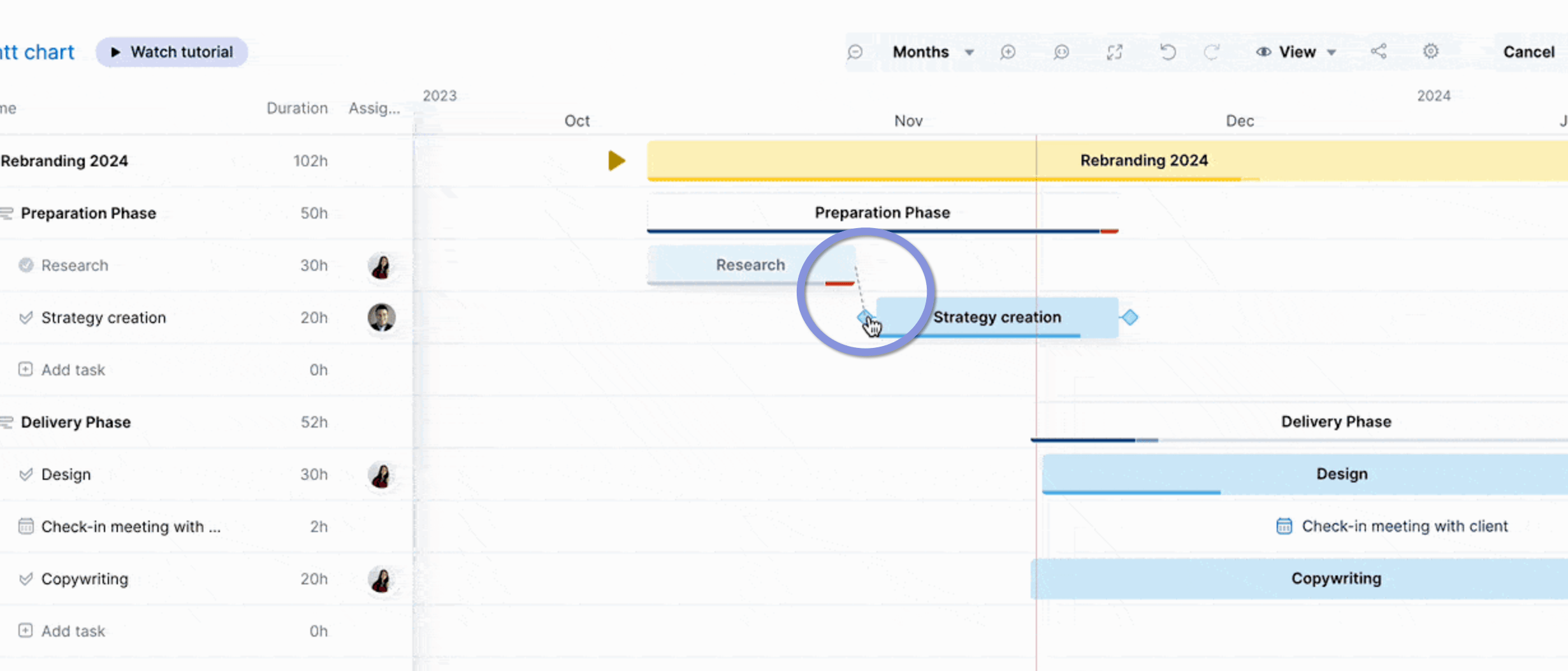
Now, if you need to move tasks around, all dependent tasks will automatically adjust with those changes.
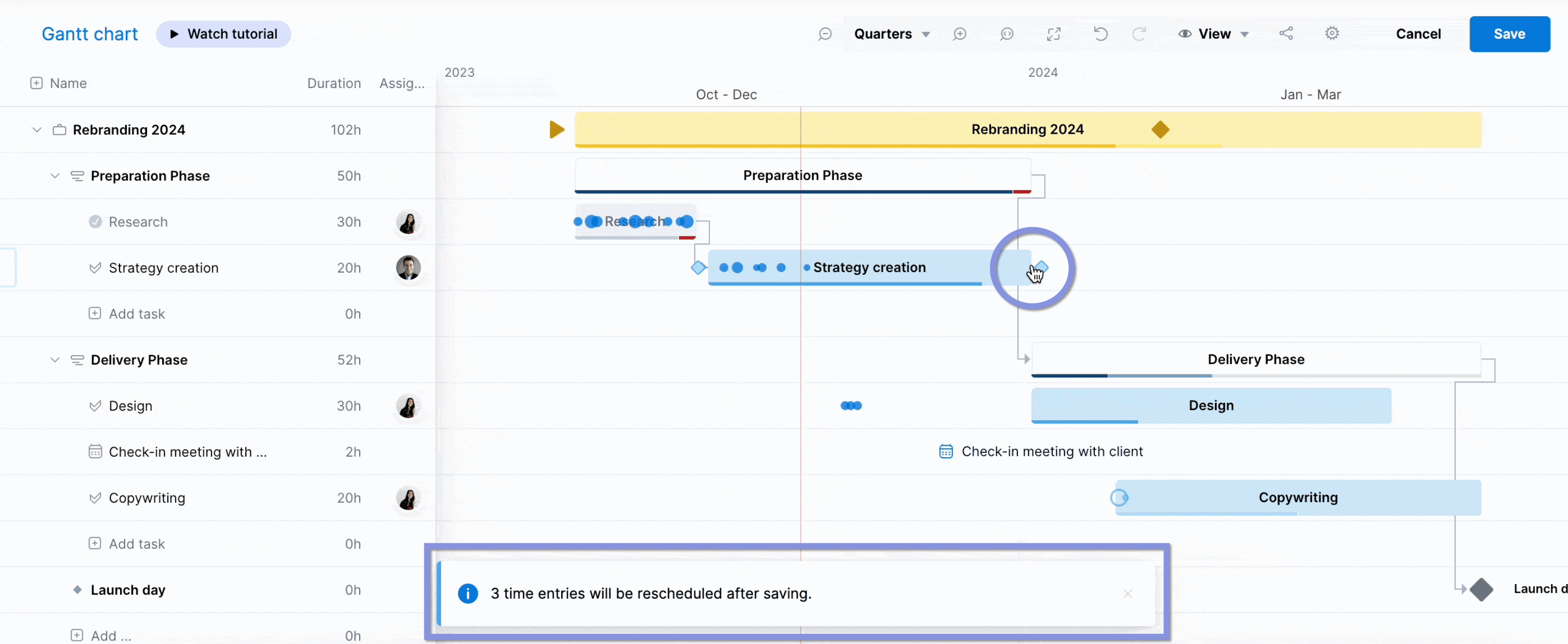
4. Staff projects based on team members’ skills and goals
Don’t assign work solely based on your team’s availability. Factor in their experience, talents, and career aims, too.
Why?
Because team members are more likely to deliver work on time (or even before a deadline hits) when it aligns with their expertise or interests.
Case in point:
According to The HR Digest, companies that regularly “invested in employee development” saw a 24% increase in productivity and a 58% increase in employee retention.
If you know who you want to assign a task to, head to Scoro’s Gantt chart and click on the “Assignee” icon in the sidebar. Then, hover over the team member.
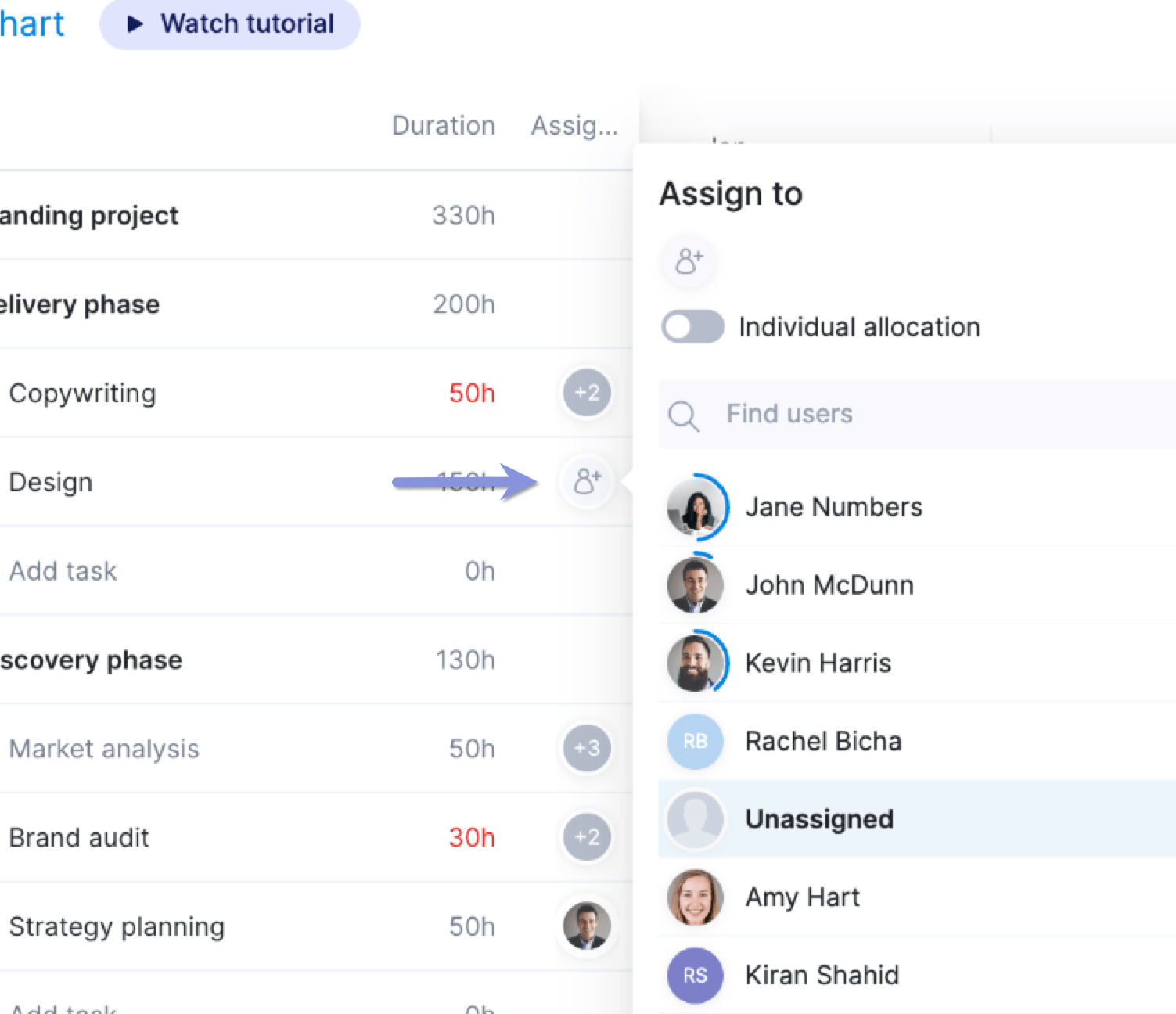
As you hover over their name, you’ll see detailed capacity data pop up. And the blue circle around their profile picture shows their remaining availability on the dates the task will be scheduled for.
Use these insights to create balanced workloads and avoid overbookings.
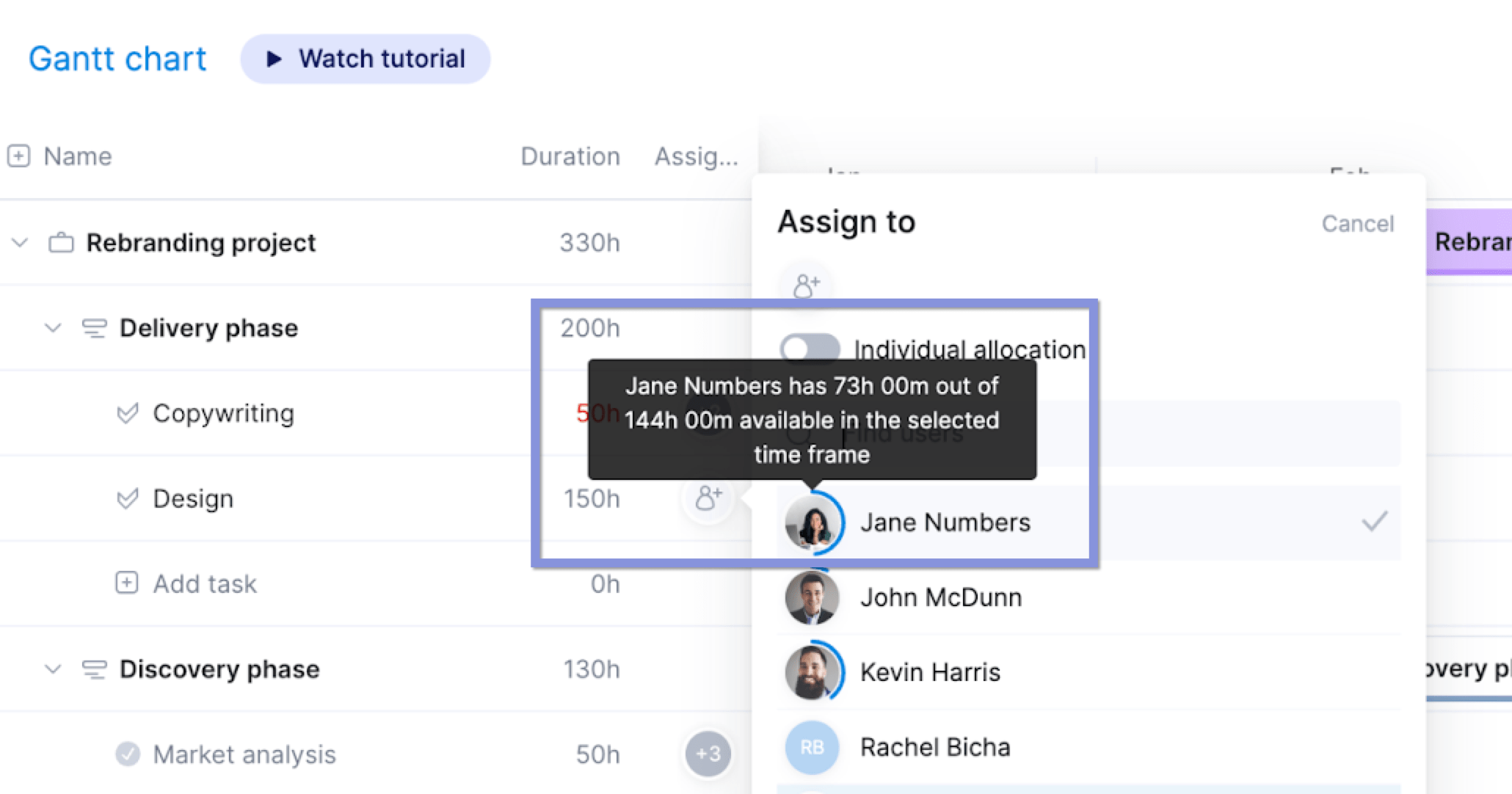
But if you’re not sure who should take on an assignment, go to the “Planner” view.
Click the “All projects” filter on the left-hand sidebar and choose the project you’re working on. You’ll see all unassigned tasks on the left. And team members’ schedules, availability, and currently assigned tasks are shown on the right.
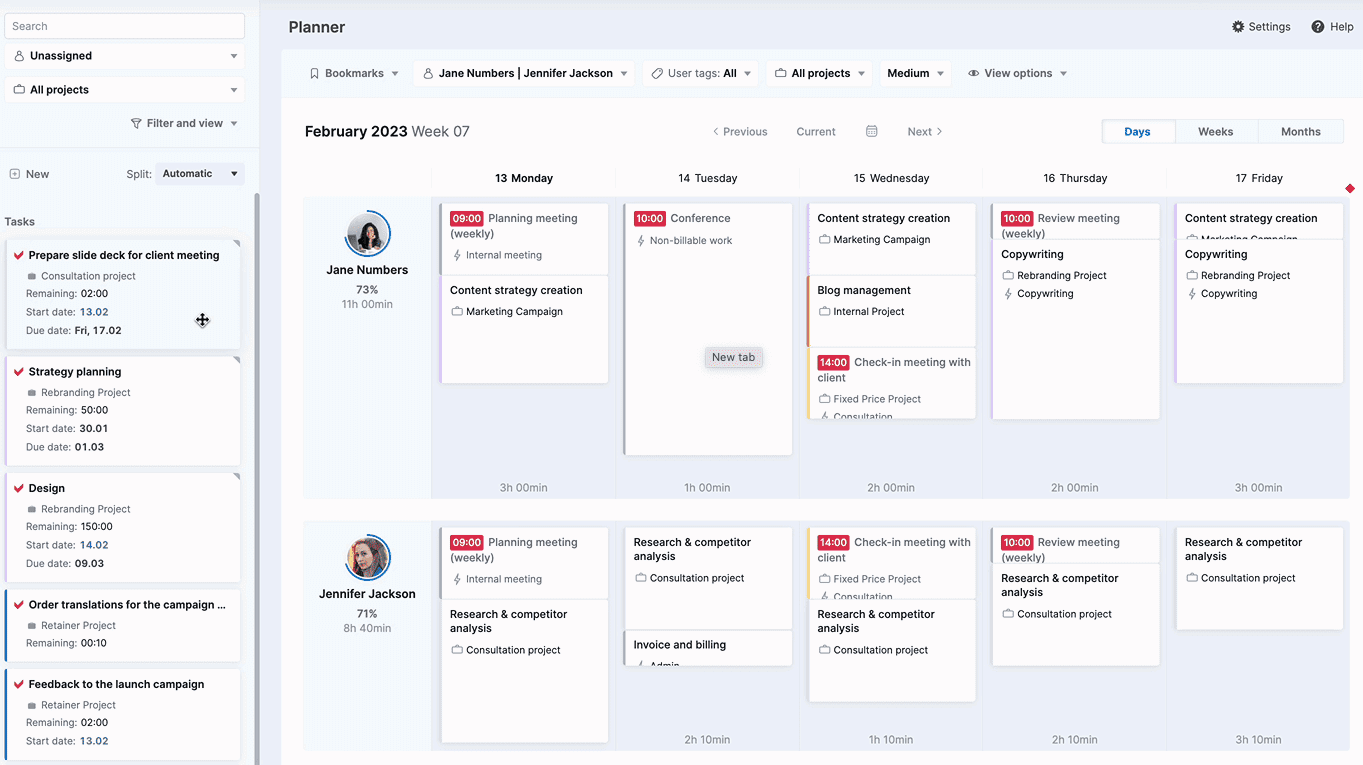
Now, use the “User tags” filter to select the skills needed for the specific task. This way, you’ll only see team members who have the required experience and availability to get the work done.
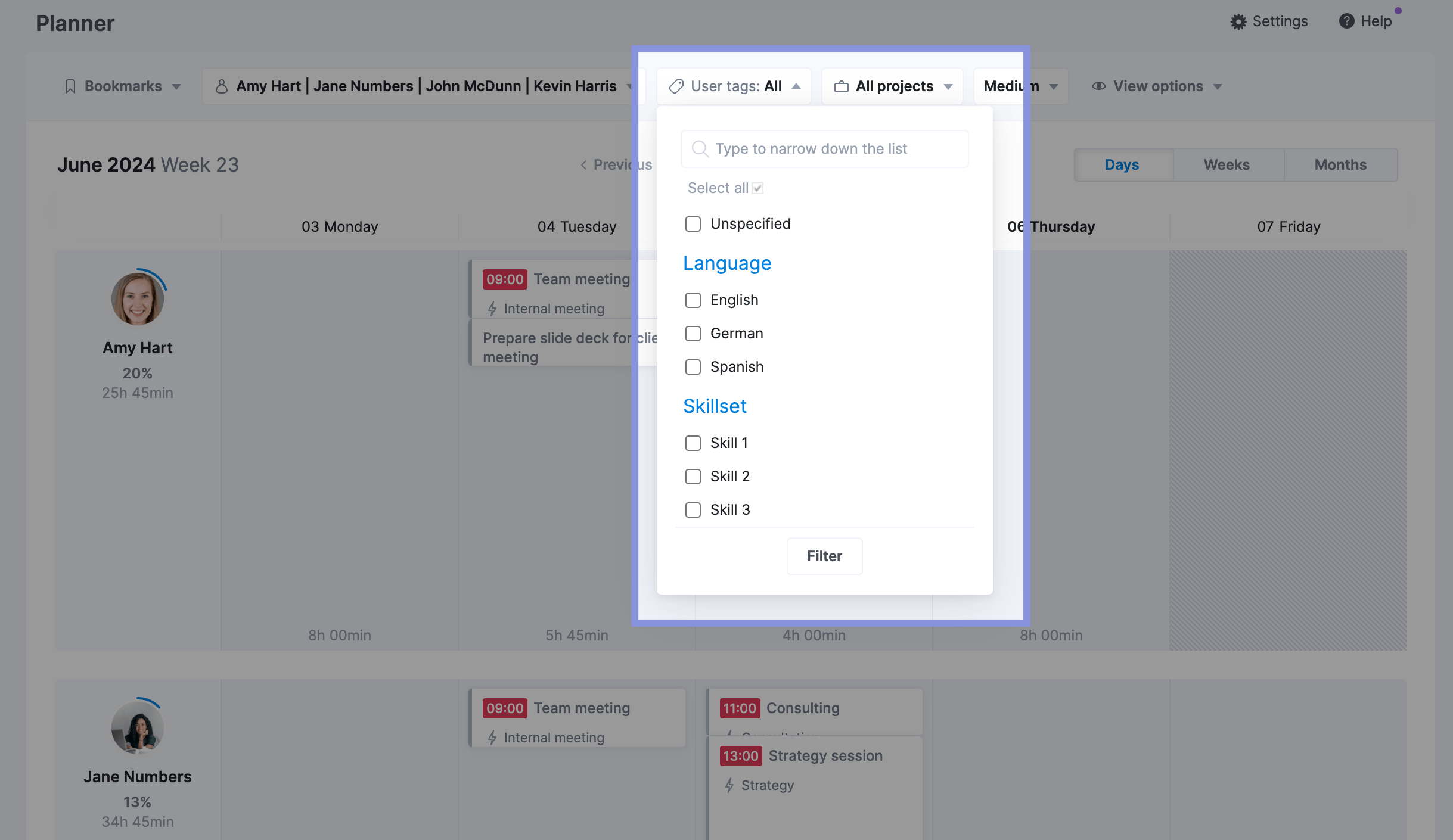
Then, drag and drop tasks from the sidebar to a team member’s calendar to assign that work to them. As you do this, their capacity numbers will automatically update.
Double-check that your assignments don’t push any team members above 80% utilization to avoid burnout and delays.
If they do, reassign as necessary until everyone is between 70% to 80% utilization. This range makes the most of their time while still leaving them enough room for admin tasks, L&D, and breaks.
5. Log time spent on tasks
Tracking time is key to hitting deadlines, preventing overservicing, and making more precise time estimates for future projects.
Say you budgeted 50 hours for designing 10 new landing pages. If you see that 30 hours of time has already been logged but your team has only finished three pages, you’ll know you’ll need to immediately step in to get things back on track. And that you might need to plan more hours for other similar tasks in the future.
It’s also important to track both billable and non-billable time.
So, you can make sure you’re billing for all relevant project work. And see where you can potentially reduce non-billable tasks to free up your team for more revenue-generating work.
Scoro makes time tracking easy. Just click the stopwatch icon in the header from any page, then click or search for the task you’re working on. Then, click the “play” icon to start the time tracker.
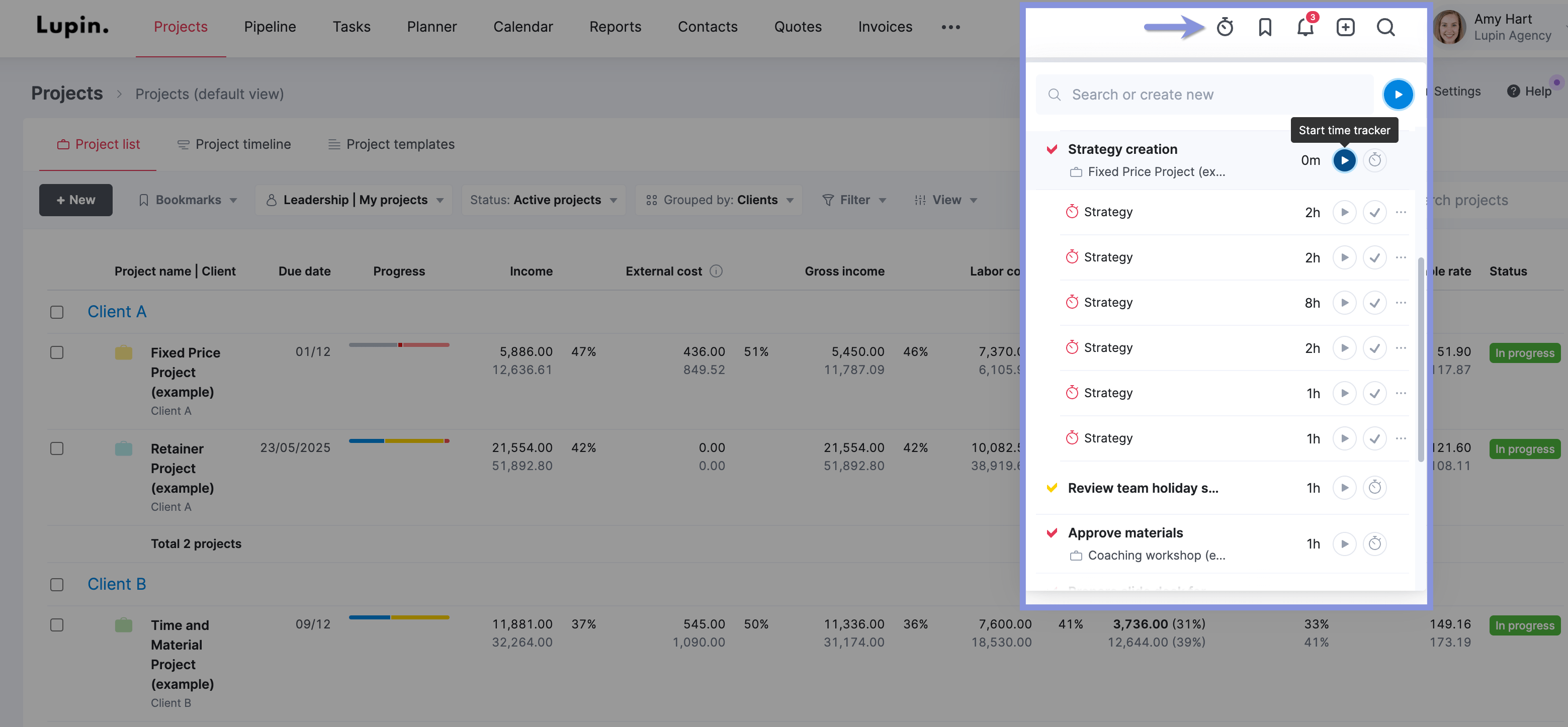
You can also track time directly from your task list by clicking the stopwatch and “Start time tracker.”
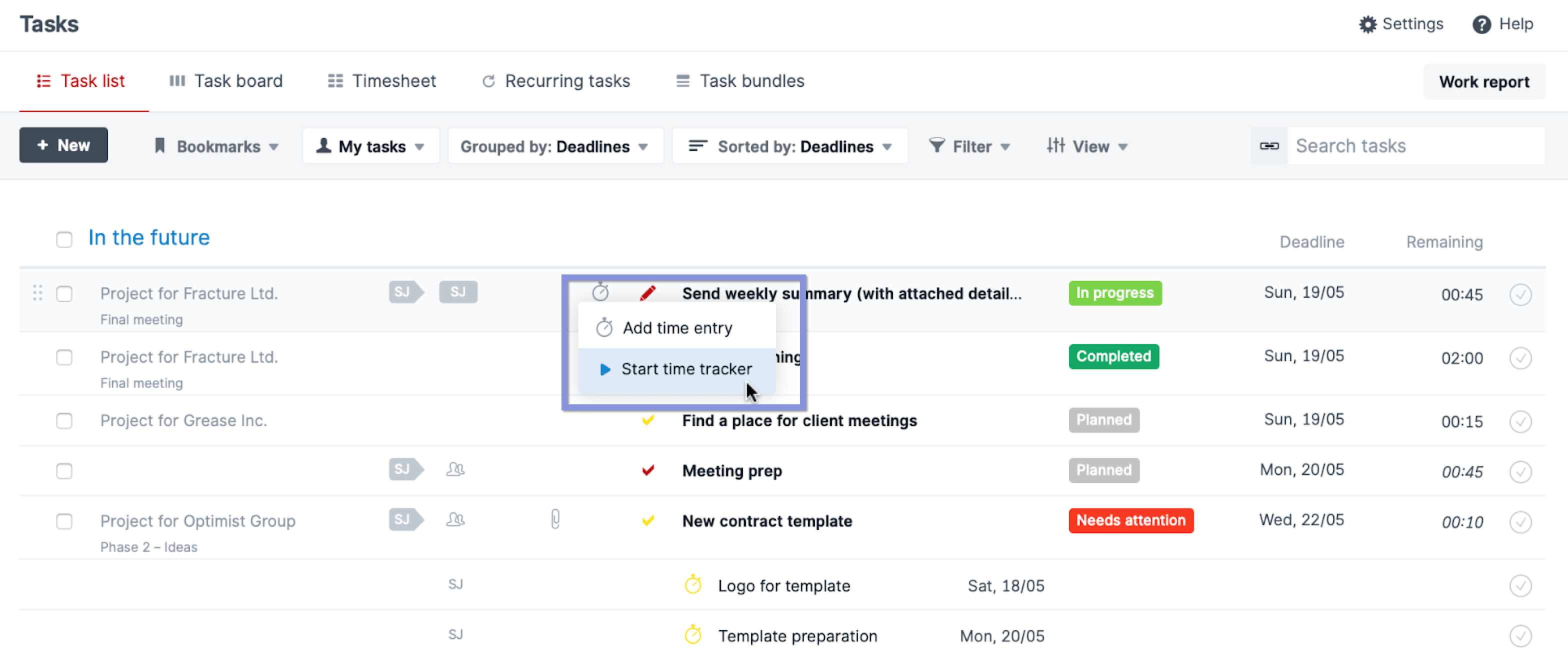
Both options automatically log the tracked time under your tagged project tasks. So, you can quickly see which activities are taking up the most (and least) amount of your team’s time.
To see all tracked time entries for your project, go to the “Time” tab in the “Project” view. This overview will help you spot any issues with overservicing or budgeting from one place.
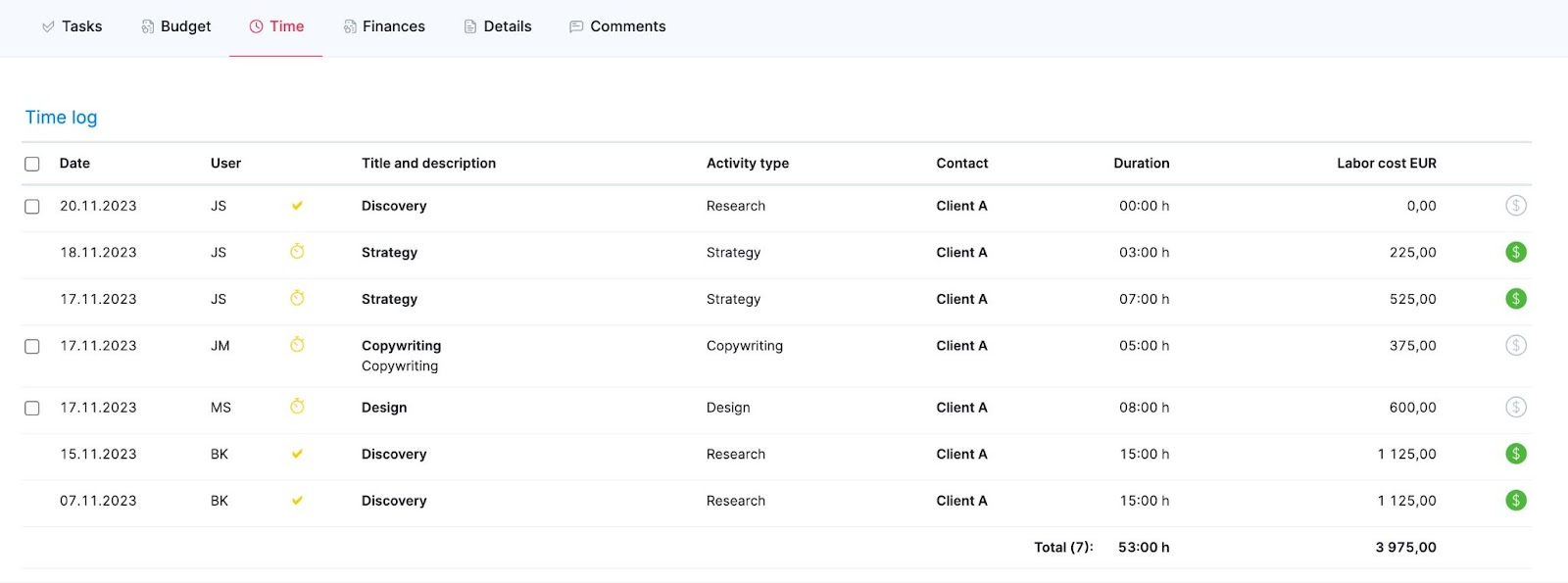
Further reading: Billable Hours: A Guide for Professional Services Businesses
6. Review projects regularly
Set up a regular cadence for project monitoring. Incorporating consistent check-ins into your workflows helps you stay on top of all moving parts across your portfolio.
Using different project tracking methods gives you detailed looks at how tasks are progressing and what needs to be prioritized to ensure on-time delivery. And offers comprehensive data to help you spot issues or roadblocks before they become costly problems.
Let’s run through a few different ways you can track projects in Scoro.
1. Build a project overview dashboard for a clear, top-level view
Scoro’s customizable dashboards are a huge help for PMs tracking multiple projects at the same time.
They let you track key project metrics in one spot, making it easy to identify big-picture trends or issues early on.
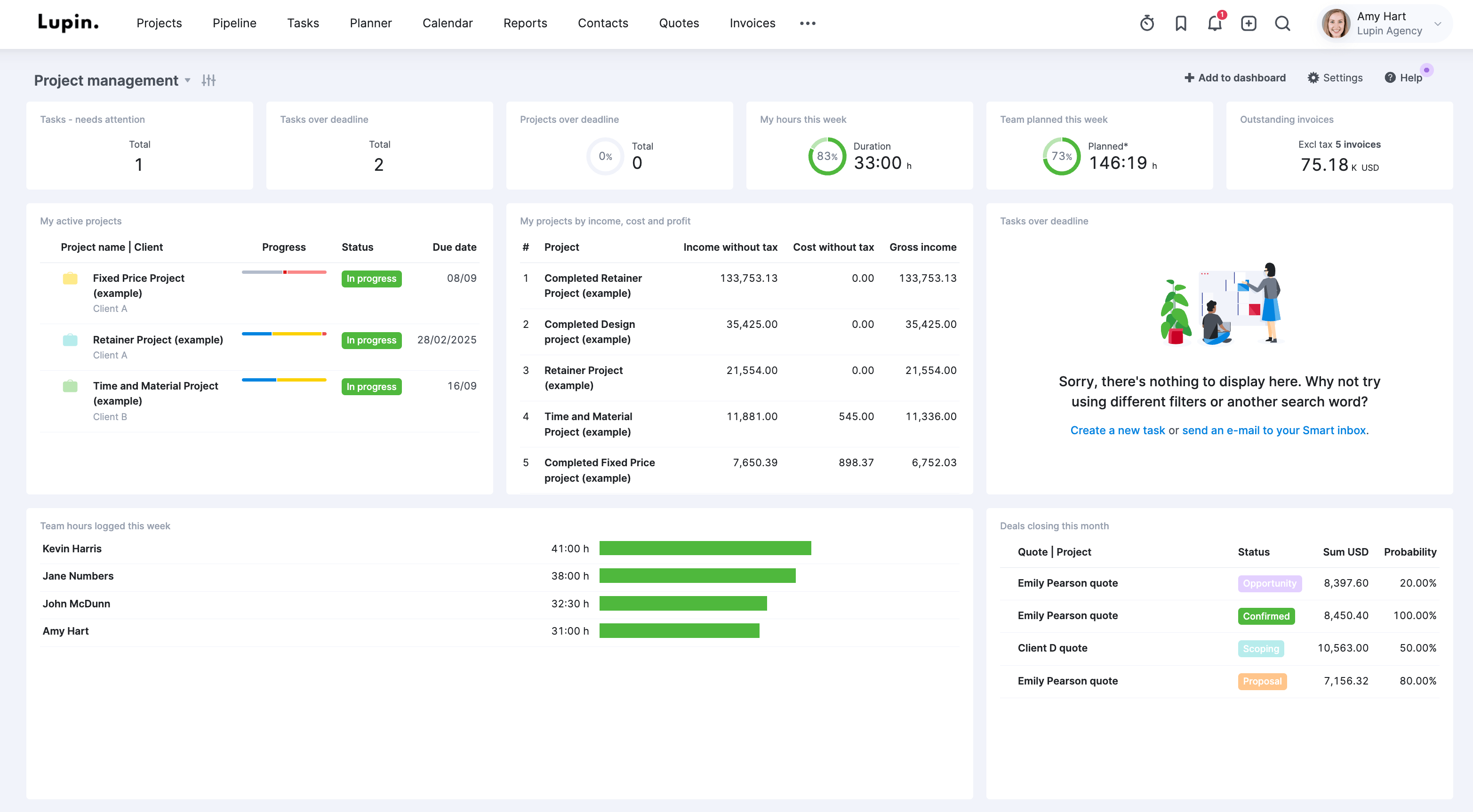
To create a new dashboard, click the “Configure the dashboard” button next to the dashboard header. Then, click “+ New Dashboard.”
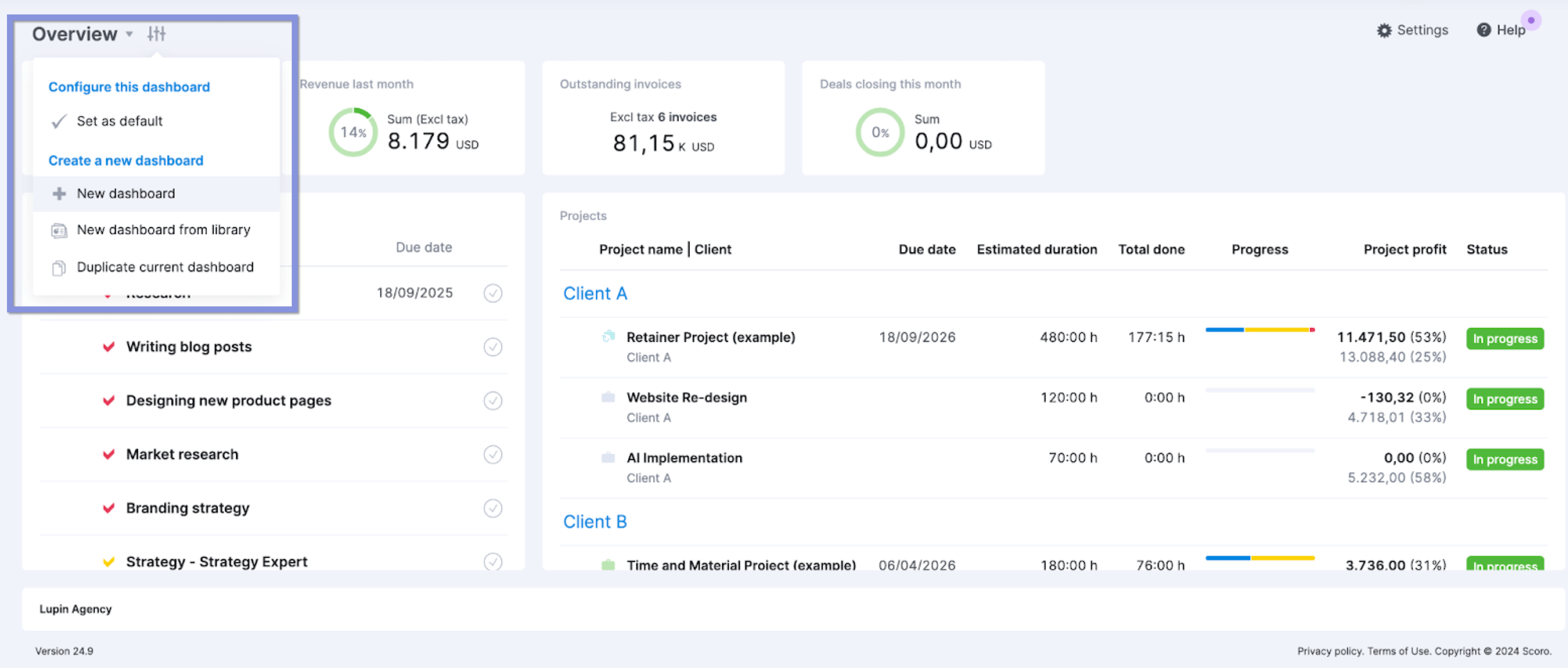
Name your dashboard and check the “Shared with other users” box if you want to give access to team members or clients. Then, click “Save.”
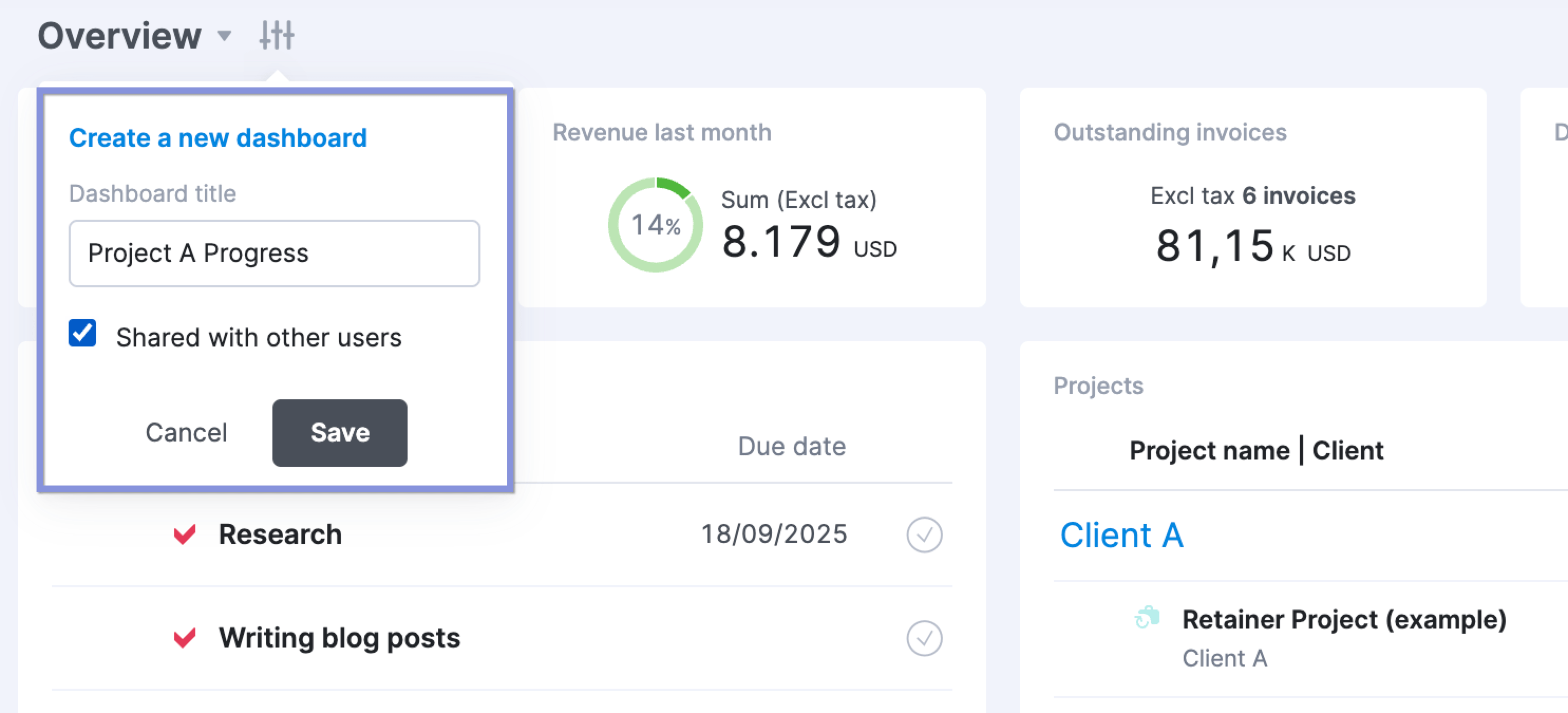
Next, click “Add to Dashboard” and pick which type of widget you want to add. From there, choose the data source for that metric and configure the widget to show the specific data points you want.
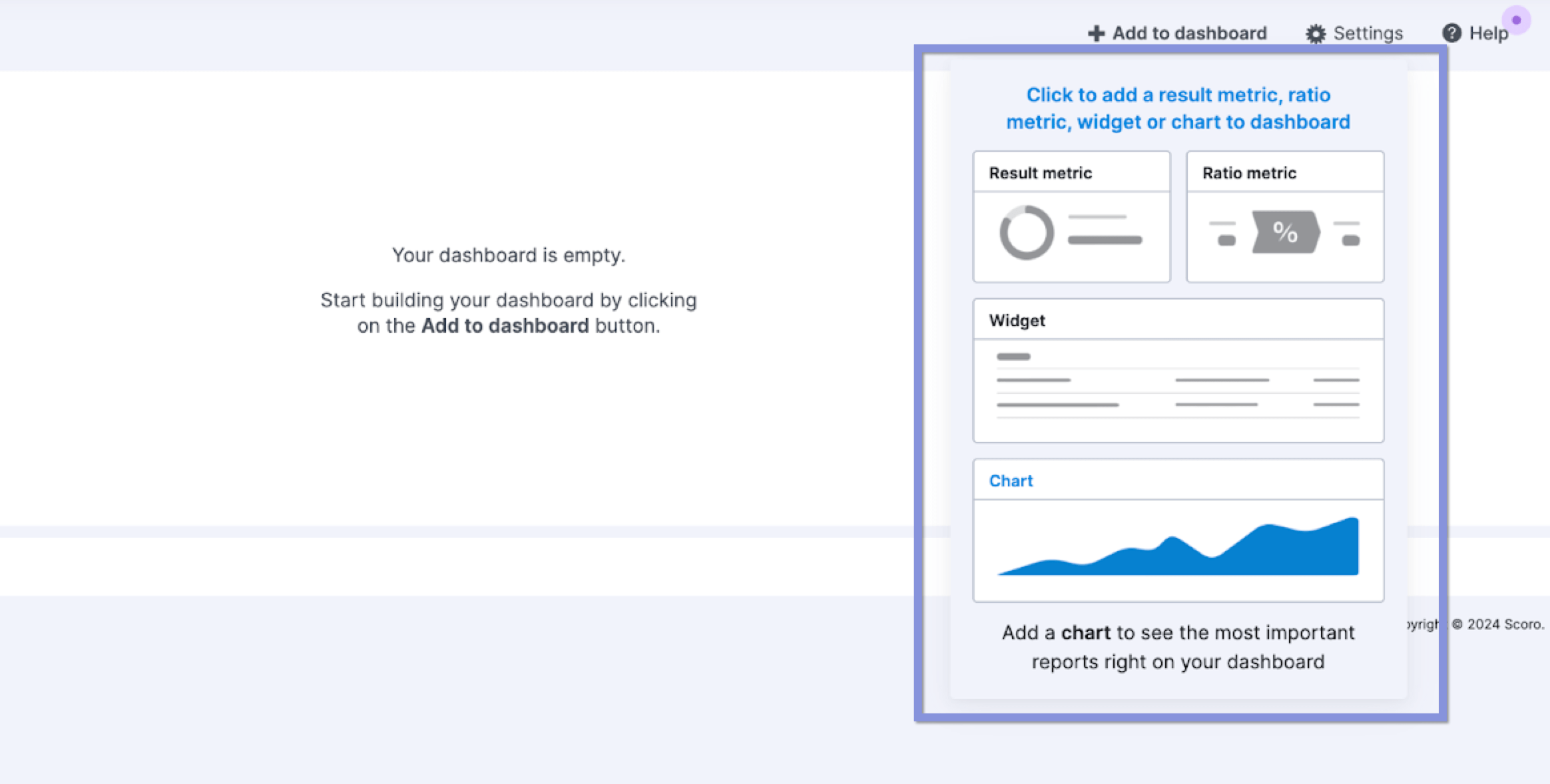
Top Tip
Consider giving internal teams and clients access to specific project management dashboards. This way, everyone can stay updated—and you have extra sets of eyes to catch any red flags.
2. Use a Gantt chart for weekly reviews
If your team doesn’t tend to have a ton of complicated work happening at the same time, a Gantt chart is a great way to track progress and align on project schedules and timelines.
Scoro’s Gantt chart highlights your critical path and dependencies while also highlighting potential delays.
Toggle between views for days, weeks, months, quarters, or years to stay on top of current and upcoming work.
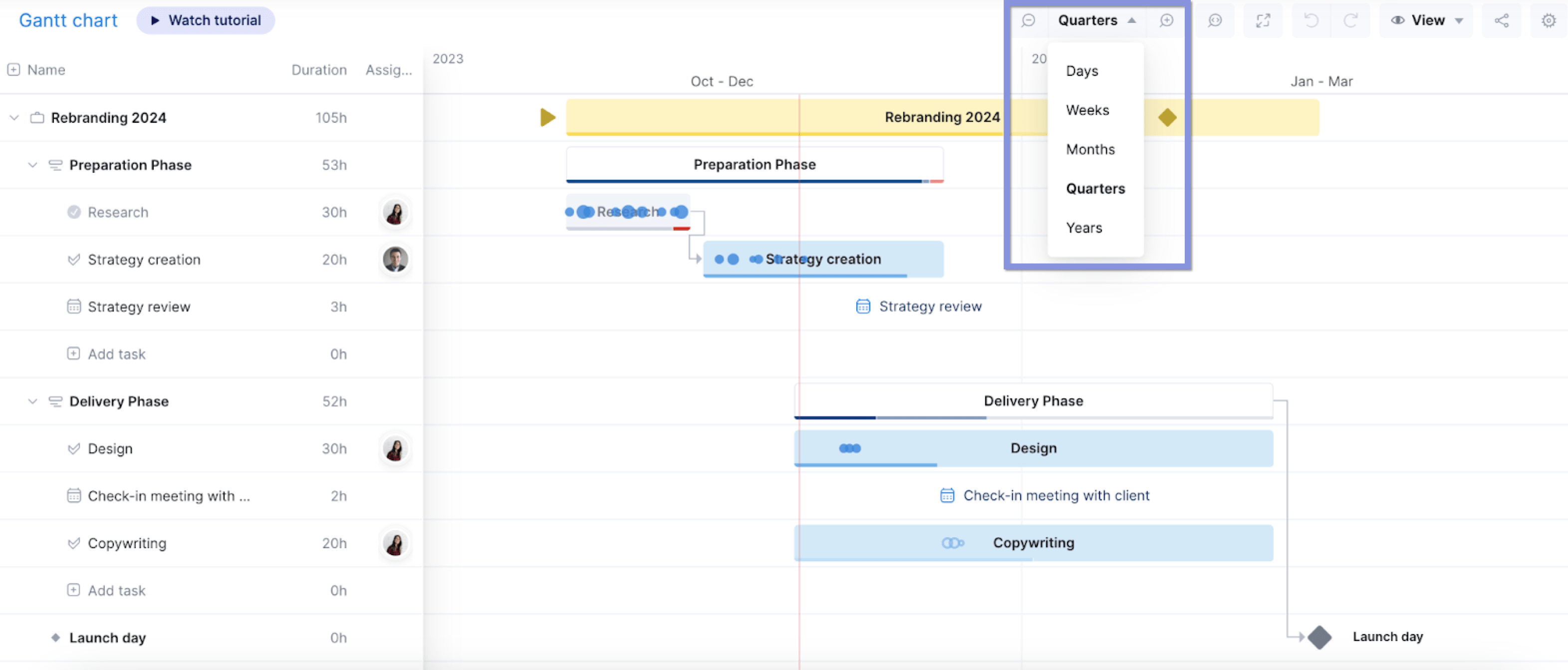
To adjust project schedules or timelines based on changing priorities or availability, just drag and drop tasks or task lengths.
3. Use Kanban boards for day-to-day management
Big teams juggling lots of projects might need to do a daily check-in to stay on top of project work. This is where a Kanban board comes in handy.
Each task is labeled under different stages (e.g., “To-Do,” “In Progress,” “Done”), so you can clearly see where things stand at any time.
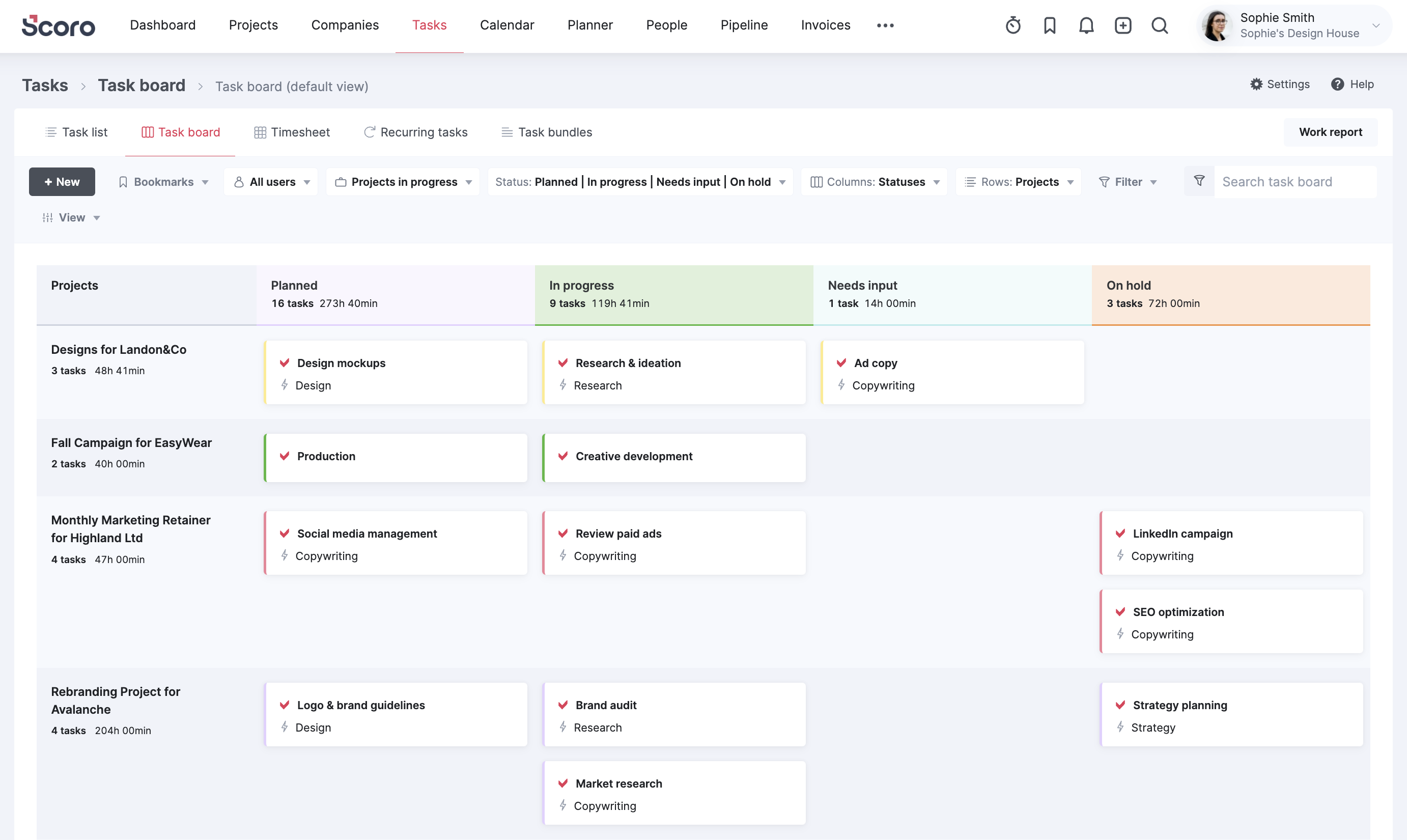
Adjust tasks and statuses as needed based on your team’s updates. And reallocate work as needed to keep everything moving.
7. Compare progress against your initial project plan
Use Scoro’s “Quoted vs. actual” table to quickly compare your project’s progress to your initial project plan. Including your spending, costs, revenue, and profits.
This way, you can identify and address deviations that signal potential problems with delivering the project on time, within budget, or in line with your goals.
Go to the Project view. Then, click the “Budget” tab → “Quoted vs Actual.”
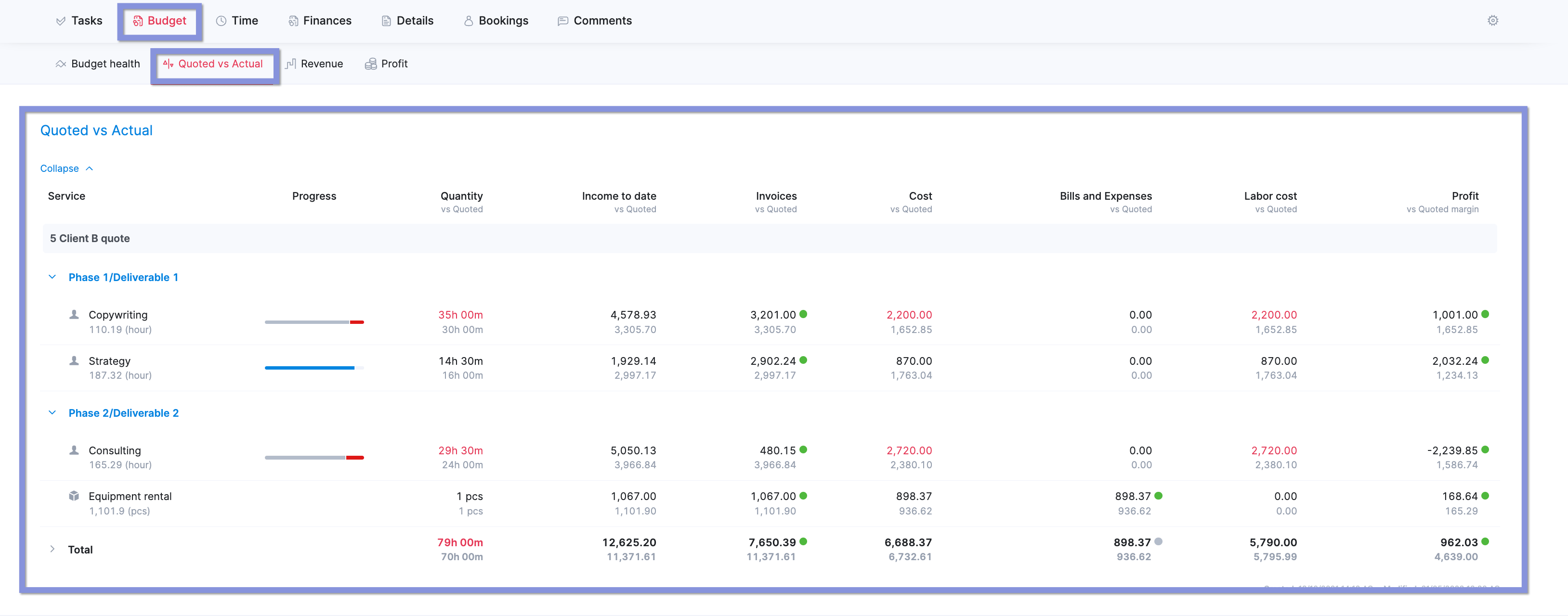
Here, you’ll see each phase of the project, a progress bar, and data columns showing details on:
- Project progress
- Quantity
- Income to date
- Invoices sent
- Cost
- Bills and expenses
- Labor costs to date
- Profit
All of these category’s actual amounts (in black) are compared to the estimated amounts (in gray), so you can clearly see where you might be lagging or pulling ahead of estimates.
For example, in the “Strategy” phase, the progress bar shows it’s about halfway complete—with the Quantity column noting you’ve spent 10 hours out of an estimated 20. And in the Profit column, your current total profit margin based on income and project costs is $750 (compared to an estimated $200).
Do I really need project tracking software?
Dedicated project tracking software makes a big difference for agencies and professional service businesses in terms of productivity, project profitability, and business growth.
For example, Colleen Kelley, President of Management Consulting for Stratford Group, explained that her team initially tracked projects across “a disparate range of manual systems (like Excel).” But she knew they needed to switch to a single source of truth to be truly effective. After a lengthy search, they decided Scoro was the best fit.
“We can now be highly accurate on project profitability,” she said. “Even during the pandemic, we were able to grow. If we didn’t have the Scoro system in place, I don’t think we could have done it.”
Indie advertising and tech marketing agency feat. also saw massive benefits after implementing Scoro’s comprehensive project tracking tool.
- Grew from €0 to €550k
- Saved each employee over an hour each day
- Optimized billing processes for over 250 projects
See more examples of how project tracking software like Scoro can transform your not only your projects, but your entire business.
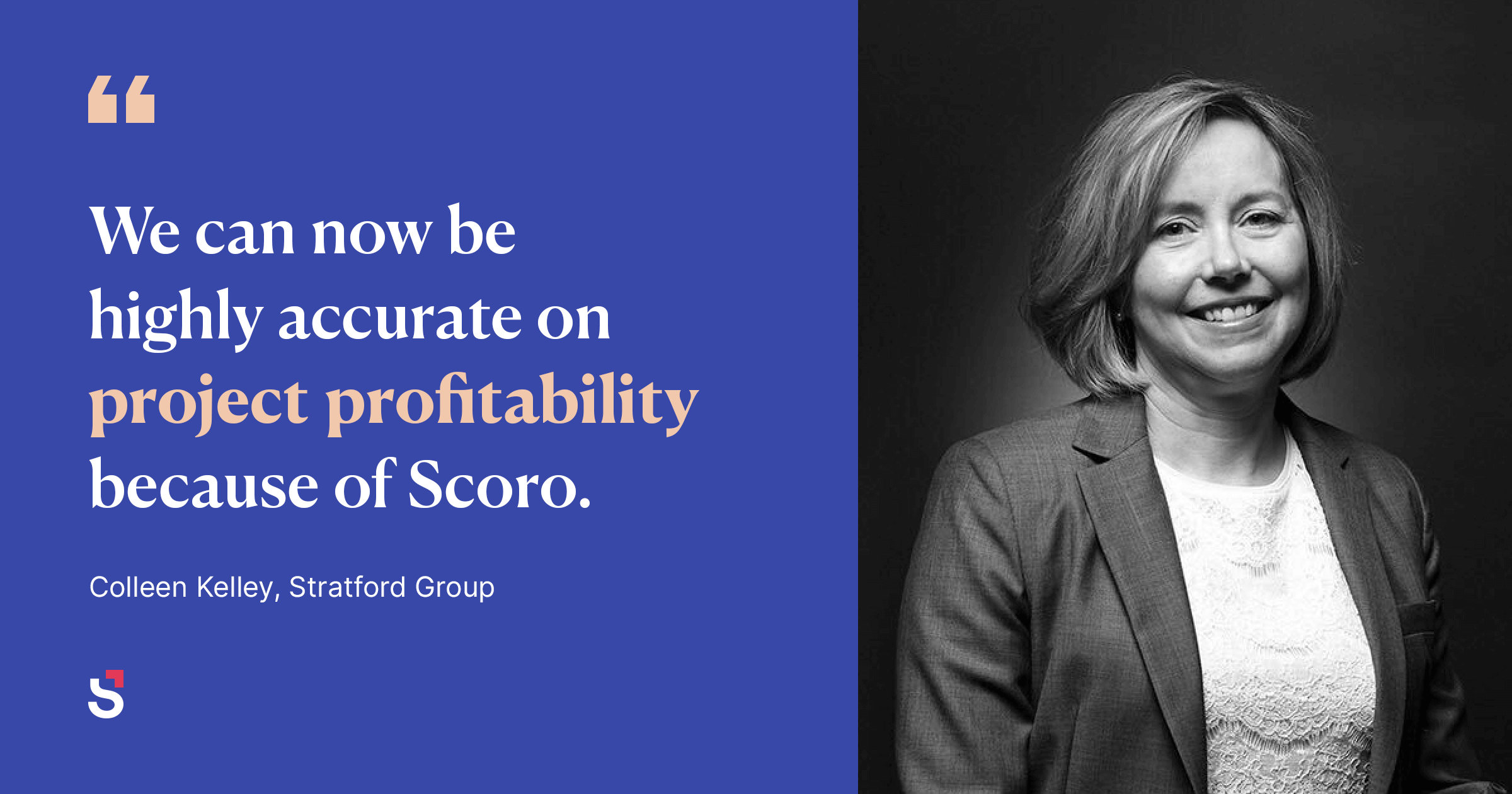
Make project tracking seamless with Scoro
Project tracking gives you the visibility you need to understand project progress, deliver projects on time, allocate staff effectively, and improve project profitability.
But what about visibility into all parts of the project lifecycle?
That’s where Scoro comes in. It’s not just for project tracking—it also covers everything from quoting and sales to invoicing, billing, and cost management in one place.
Not only does this centralization save time, it saves your business money. Use one tool to get the job done instead of multiple, disconnected (and costly) platforms.
Try Scoro’s 14-day free trial and see how our professional services automation (PSA) tools can help your business grow.





